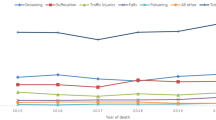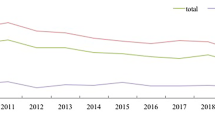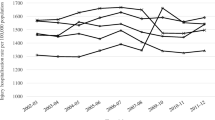Abstract
Objectives
To perform an interprovincial comparison of unintentional population-based injury hospitalization and death rates for Canadian children ages 0–19 years and compare trends between 2006 and 2012.
Methods
Annual population-based hospitalization rates per 100,000 from unintentional injuries were calculated for children/youth (< 19 years) using data from the Discharge Abstract Database between 2006 and 2012. Annual mortality rates were analyzed using provincial coronial data. The mean annual change in the rate of hospitalizations due to unintentional injuries was reported for each province.
Results
The average annual rate of hospital admissions for unintentional injuries was 305.10 per 100,000 population between 2006 and 2012, and this decreased by − 11.91 over time (p < 0.01, − 15.85; − 7.77). Saskatchewan had the highest average annual morbidity rate (550.76 per 100,000) from all unintentional causes, and Ontario had the lowest average annual rate (238.89 per 100,000). Saskatchewan had the highest average annual rate for all subcauses except for drowning. Ontario was the only province with an average annual injury morbidity rate that was consistently below the Canadian average. The average annual mortality rate from all unintentional injury was highest in Saskatchewan (17.51 per 100,000) and lowest in Ontario (5.99 per 100,000) when compared to Canada (7.97 per 100,000).
Conclusion
Injury prevention policies vary considerably among provinces. Although the unintentional injury hospitalization rate is decreasing over time, some subcauses such as choking/suffocation have shown an increase in certain provinces. Evidence-based childhood injury prevention policies, such as playground equipment safety and four-sided pool fencing among others, should be standardized across Canada.
Résumé
Objectifs
Effectuer une comparaison interprovinciale des taux d’hospitalisation et de mortalité dus aux blessures non intentionnelles dans la population des enfants canadiens de 0 à 19 ans et comparer les tendances entre 2006 et 2012.
Méthode
Les taux d’hospitalisation annuels p. 100 000 habitants dus aux blessures non intentionnelles ont été calculés pour les enfants et les jeunes (< 19 ans) à l’aide des données de la Base de données sur les congés des patients pour la période de 2006 à 2012. Les taux de mortalité annuels ont été analysés à l’aide des données des coroners provinciaux. Le changement annuel moyen du taux d’hospitalisation pour blessures non intentionnelles a été déclaré pour chaque province.
Résultats
Le taux annuel moyen d’hospitalisation pour blessures non intentionnelles a été de 305,10 p. 100 000 entre 2006-2012 et a diminué de -11,91 avec le temps (p < 0,01, -15,85; -7,77). La Saskatchewan a affiché le taux annuel moyen de morbidité le plus élevé (550,76 p. 100 000), toutes causes non intentionnelles confondues, et l’Ontario, le taux annuel moyen le plus faible (238,89 p. 100 000). La Saskatchewan a présenté le taux annuel moyen le plus élevé pour toutes les causes secondaires sauf les noyades. L’Ontario a été la seule province où le taux annuel moyen de morbidité était systématiquement en deçà de la moyenne canadienne. Le taux annuel moyen de mortalité pour l’ensemble des blessures non intentionnelles a été le plus élevé en Saskatchewan (17,51 p. 100 000) et le plus faible en Ontario (5,99 p. 100 000) par rapport à la moyenne canadienne (7,97 p. 100 000).
Conclusion
Les politiques de prévention des blessures varient considérablement d’une province à l’autre. Bien que le taux d’hospitalisation pour blessures non intentionnelles ait diminué au fil du temps, certaines causes secondaires, comme l’étouffement/la suffocation, sont en hausse dans certaines provinces. Les politiques de prévention des blessures chez les enfants fondées sur les preuves, entre autres les politiques sur la sécurité des équipements de jeu et sur les clôtures à quatre côtés autour des piscines, devraient être normalisées à l’échelle du Canada.
Similar content being viewed by others
References
American Academy of Pediatrics. (2010). Policy statement—prevention of choking among children. Pediatrics, 125(3), 601–607.
Canadian Institute for Health Information (CIHI) (2016) Discharge Abstract Database (DAD) Metadata. Available at: https://www.cihi.ca/en/types-of-care/hospital-care/acute-care/dad-metadata. Accessed October 4, 2017.
Canadian Standards Association (n.d.) Children’s play spaces and equipment Z614–07, 2007.
Chen, Y., Mo, F., Yi, Q. L., Jiang, Y., & Mao, Y. (2013). Unintentional injury mortality and external causes in Canada from 2001 to 2007. Chronic Diseases and Injuries in Canada, 33(2), 95–102.
Clemens, T., Tamim, H., Rotondi, M., & Macpherson, A. K. (2016). A population based study of drowning in Canada. BMC Public Health, 16(559), 1–8.
Howard, A. W., Macarthur, C., Willan, A., Rothman, L., Moses-McKeag, A., & Macpherson, A. K. (2005). The effect of safer play equipment on playground injury rates among school children. Canadian Medical Association Journal, 172(11), 1443–1446.
IBM Corp (n.d.) Released 2016. IBM SPSS statistics for Windows, Version 24.0. Armonk, NY: IBM Corp.
MacKay, M., Vincenten, J., Brussoni, M., Towner, E., Fuselli, P. (n.d.) Child Safety Good Practice Guide: good investments in unintentional child injury prevention and safety promotion—Canadian Edition. Available at: http://www.parachutecanada.org/downloads/research/reports/ChildSafetyGoodPracticeGuide-CanadianEdition.pdf. Accessed October 4, 2017.
Macpherson, A. K., Brussoni, M., Fuselli, P., Middaugh-Bonney, T., Piedt, S., & Pike, I. (2015). An evaluation of evidence-based paediatric injury prevention policies across Canada. BMC Public Health, 15(707), 1–7.
Pan, S. Y., Desmeules, M., Morrison, H., Semenciw, R., Ugnat, A. M., Thompson, W., & Mao, Y. (2007). Adolescent injury deaths and hospitalization in Canada: magnitude and temporal trends (1979-2003). The Journal of Adolescent Health: Official Publication of the Society for Adolescent Medicine, 41(1), 84–92.
Parachute (n.d.-a) The cost of injury in Canada. Available at: http://www.parachutecanada.org/downloads/research/Cost_of_Injury-2015.pdf. Accessed October 4, 2017.
Parachute (n.d.-b) Preventing drowning: safer pool fencing legalisation chart. Available at: http://www.parachutecanada.org/downloads/policy/Pool_Fencing_Legislation_Chart.pdf. Accessed October 4, 2017.
Public Health Agency of Canada (2008) Leading causes of death, Canada. Available at: http://www.phac-aspc.gc.ca/publicat/lcd-pcd97/pdf/lcd-pcd-t1-eng.pdf. Accessed October 4, 2017.
Rothman, L., Pike, I., Belton, K., Olsen, L., Fuselli, P., & Macpherson, A. K. (2016). Barriers and enables to enacting child and youth related injury prevention legislation in Canada. International Journal of Environmental Research and Public Health, 13(656), 1–11.
Spiegel, C. N., & Lindaman, F. C. (1995). Children can’t fly: a program to prevent childhood mortality from window falls. Injury Prevention, 1(3), 194–198.
Towner, E., Dowswell, T., Mackereth, C., Jarvis, S. (2001) What works in preventing unintentional injuries in children and young adolescents? An updated systematic review. Prepared for the Health Development Agency (HDA), London. Department of Child Health, University of Newcastle upon Tyne, 2001.
World Health Organization (WHO) (2014) Global report on drowning: preventing a leading killer. Available at: http://apps.who.int/iris/bitstream/10665/143893/1/9789241564786_eng.pdf?ua=1&ua=1. Accessed October 4, 2017.
Yanchar, N.L., Warda, L.J., Fuselli, P. (2012). Child and youth injury prevention: a public health approach. Injury Prevention Committee, Canadian Pediatric Society, 1–9.
Acknowledgements
A.M. is supported by CIHR - Chairs in Reproductive and Child Health Services and Policy Research (#FRN 126341).
Author information
Authors and Affiliations
Corresponding author
Rights and permissions
About this article
Cite this article
Fridman, L., Fraser-Thomas, J., Pike, I. et al. An interprovincial comparison of unintentional childhood injury rates in Canada for the period 2006–2012. Can J Public Health 109, 573–580 (2018). https://doi.org/10.17269/s41997-018-0112-z
Received:
Accepted:
Published:
Issue Date:
DOI: https://doi.org/10.17269/s41997-018-0112-z




